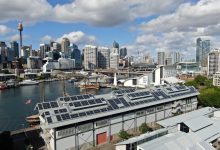The Clean Energy Finance Corporation has made a $US7 million ($A9.6 million) investment in solar pioneer Dr Zhengrong Shi’s latest venture, a lightweight “solar skin” technology developed by his privately owned Sunman company.
Dr Shi, a UNSW graduate, the founder of Suntech (once the world’s biggest solar company before its collapse) and the man once dubbed the “Sun King” has raised $US12 million in the latest funding round, mostly from the CEFC but also from Australia’s Southern Cross Ventures and his own money.
The “solar skin” technology is a lightweight and flexible form of solar PV using a polymer-based “skin” that makes it suitable for unconventional rooftops and the huge amount of warehouse roofs that cannot support conventional heavier modules. It has already been used on notable installations such as the National Maritime Museum in Sydney and on Byron Bay’s solar train.
The CEFC says the solar skin technology has the potential to “revolutionise Australia’s use of rooftop solar”, and the new funding round will enable Sunman to invest in more R&D, optimise installation processes and help develop markets for its product.
Dr Shi says the solar skin technology, sold by Sunman under the brand of “eArc” panels, are made from a lightweight polymer composite material and are 70 per cent lighter than a conventional glass panel, making them cheaper to transport and easier to install because they can be glued to a surface.
“The flexibility of the panels means they offer multiple benefits,” he says. “They can be moulded to contoured surfaces, offering potential for use beyond conventional rooftops. They can be used for mobile power generation, making them suitable for remote sites and vehicles. They can also be integrated into construction materials, to allow solar PV to be used to encase a building.”
Dr Shi is particularly interested in the commercial and industrial sector, with an eye on the thousands of rooftops that could support lightweight solar installations. But he says it has taken time for the market to understand the potential of the technology, and accept its reliability.
“It takes time for the market to recognise the importance of this technology,” Dr Shi told RenewEconomy in an interview. “There were concerns about reliability and durability, so I think the money raised in this round will help accelerate the global marketing and sales activity and accelerate the pace of product development.”
Dr Shi says the company is entering a high growth phase, with production capacity of 200MW a year at a factory near Shanghair in China, revenue in the past year of $10 million, and prospects of 50 per cent annual revenue growth. He also flagged a metal roof solar product that would marry building materials with his solar technology.
The investment by the CEFC – a rare equity contribution from Australia’s “green bank” – appears to be an endorsement.
CEO Ian Learmonth says the flexibility of Sunman’s eArc panels means it is possible to be more creative about where solar PV is installed, moving beyond flat rooftops to awnings, carports, carpark canopies and building facades.
“The lighter weight of the panels also means solar can be extended across existing rooftops on factories, warehouses, garages and other structures that are not strong enough to support heavier glass panels,” Learmonth said in a statement.
 “The eArc panels already power the Byron Bay solar train, after being moulded to fit its curved roof. They have also been installed at the Australian National Maritime Museum in Sydney, which had been unable to support glass panels because of the steep slope of its roof. The Museum estimates that the panels will cut its electricity bill by about $50,000 a year.”
“The eArc panels already power the Byron Bay solar train, after being moulded to fit its curved roof. They have also been installed at the Australian National Maritime Museum in Sydney, which had been unable to support glass panels because of the steep slope of its roof. The Museum estimates that the panels will cut its electricity bill by about $50,000 a year.”
According to 2019 research co-developed by the CEFC, Australia is using less than five per cent of its capacity for rooftop solar, and there is an untapped potential capacity of 28GW of rooftop solar in commercial and industrial sites.
“Decarbonising Australia’s energy sector is critical to our continuedtransition to a low emissions economy,” Learmonth said. “A much wider rollout of solar PV can accelerate our efforts to reduce emissions by harnessing more of our abundant solar resources.
The investment is being made through the Clean Energy Innovation Fund, which is Australia’s largest dedicated cleantech investor, drawing on $A200 million in CEFC finance to invest in early-stage clean technology companies.










